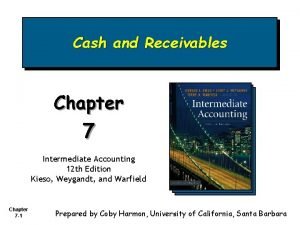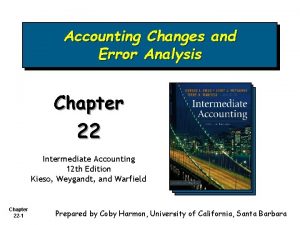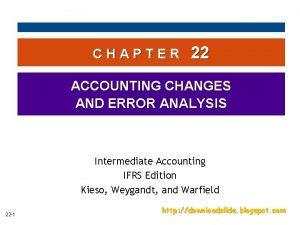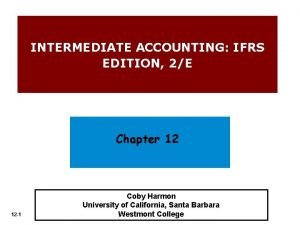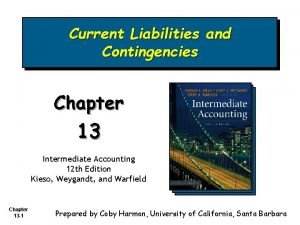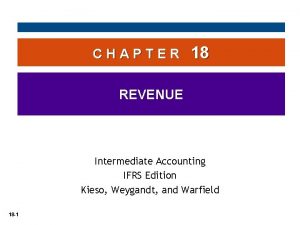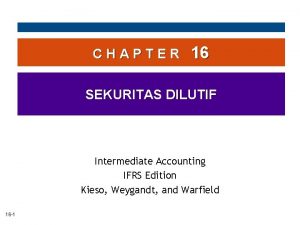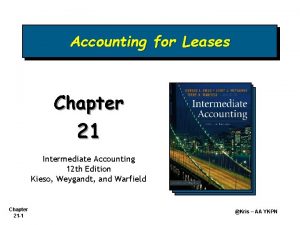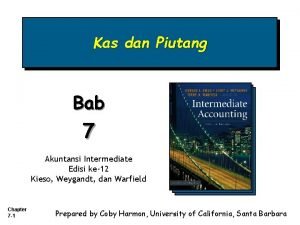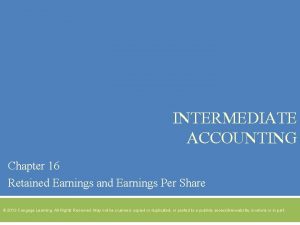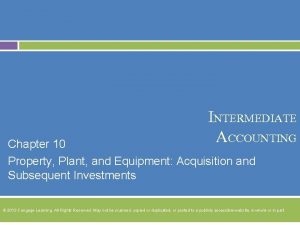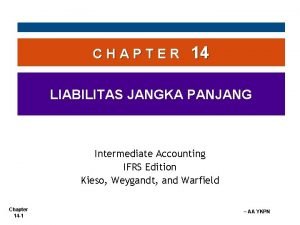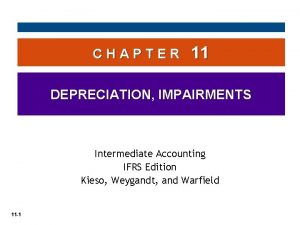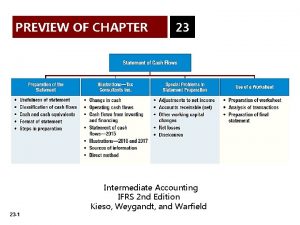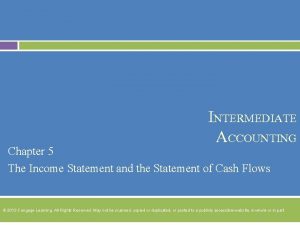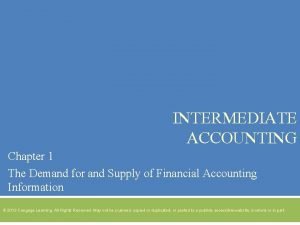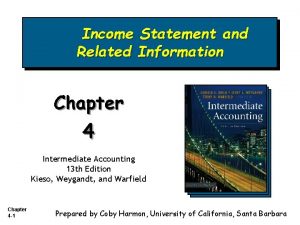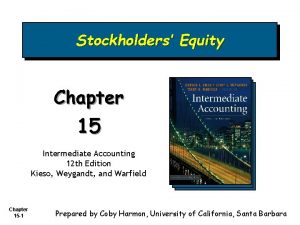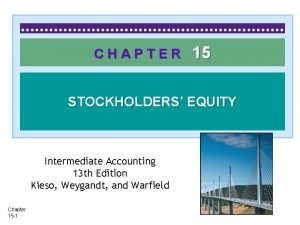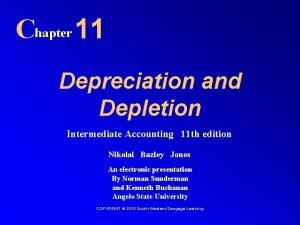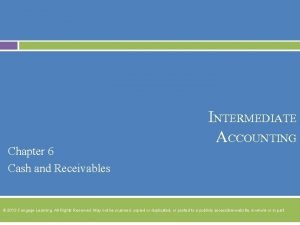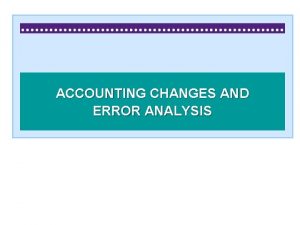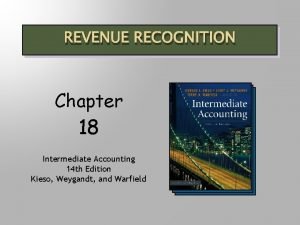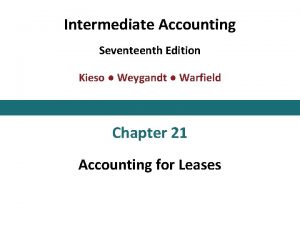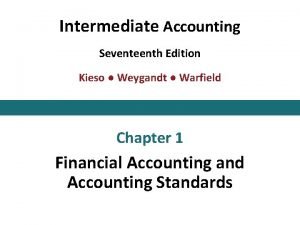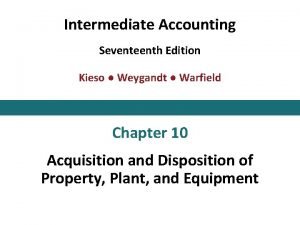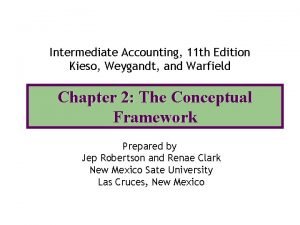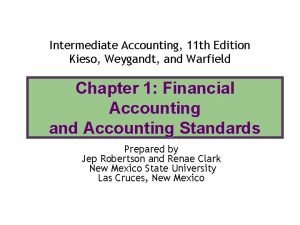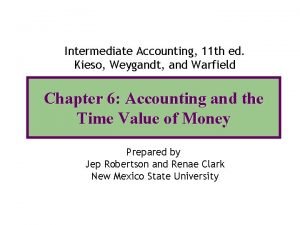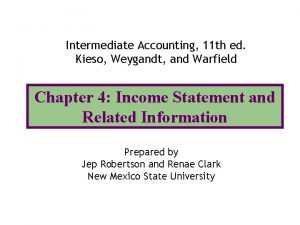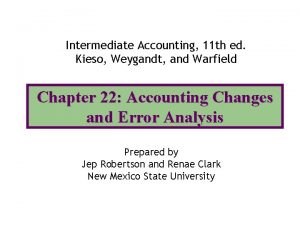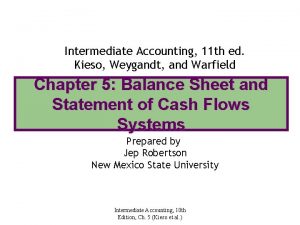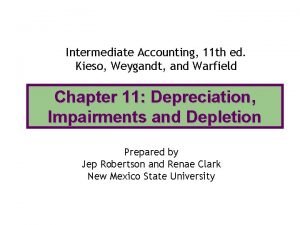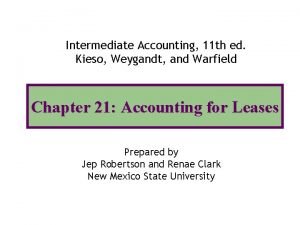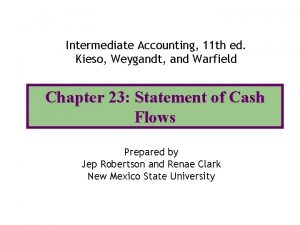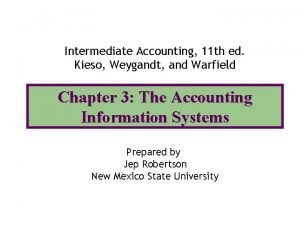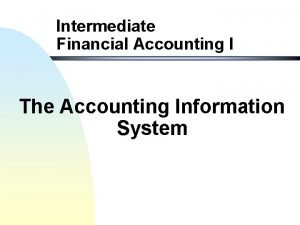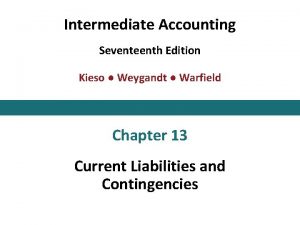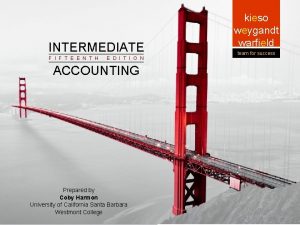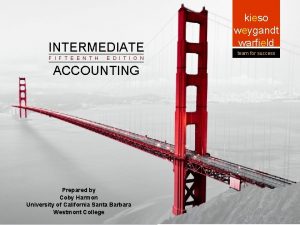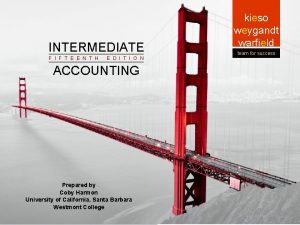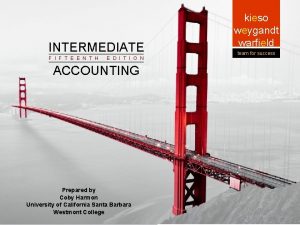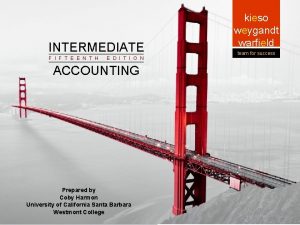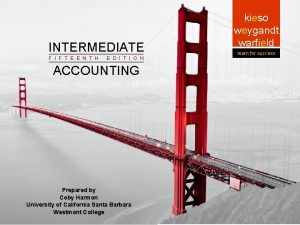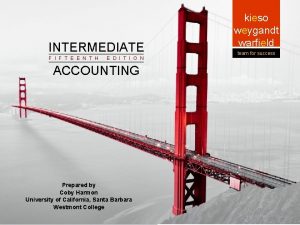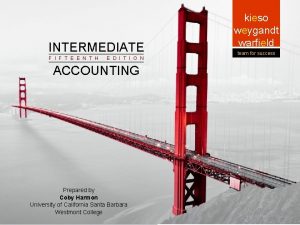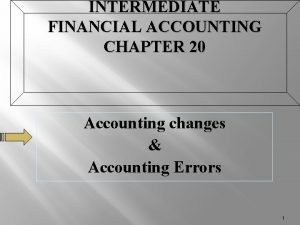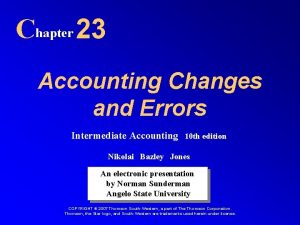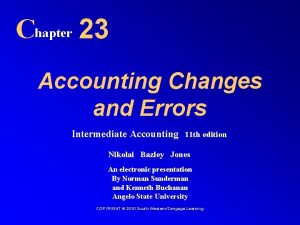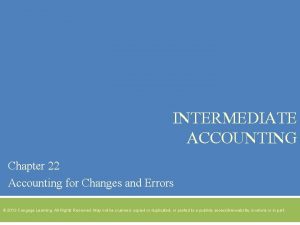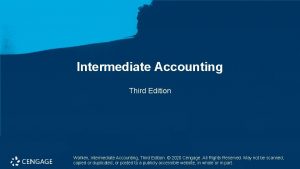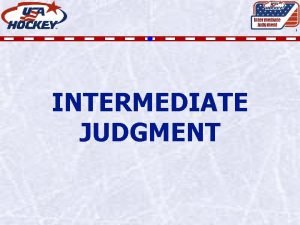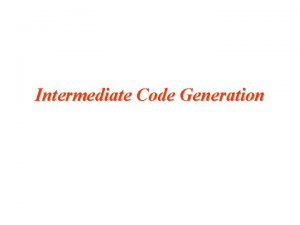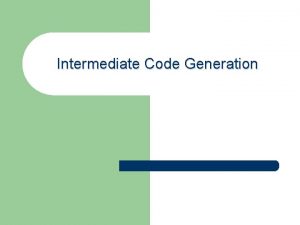INTERMEDIATE ACCOUNTING Chapter 22 Accounting for Changes and


























































- Slides: 58

INTERMEDIATE ACCOUNTING Chapter 22 Accounting for Changes and Errors © 2013 Cengage Learning. All Rights Reserved. May not be scanned, copied or duplicated, or posted to a publicly accessible website, in whole or in part.

Objectives 1. 2. 3. 4. 5. Identify the types of accounting changes and explain the methods of reporting each type of change. Account for a change in accounting principle. Account for a change in estimate. Identify a change in a reporting entity. Account for a correction of an error. © 2013 Cengage Learning. All Rights Reserved. May not be scanned, copied or duplicated, or posted to a publicly accessible website, in whole or in part.

A Change for the Better The primary objective of financial reporting is to provide useful information about a company that assists investors, lenders, and other creditors in making decisions about providing resources to the company. To achieve this objective, both the FASB and the IASB have identified comparability, which includes consistency, as a qualitative characteristic that enhances the decision-usefulness of financial information. Ideally, the consistent application of accounting methods and procedures from period to period should produce comparable information that helps users identify and explain similarities and differences between two or more sets of economic facts. © 2013 Cengage Learning. All Rights Reserved. May not be scanned, copied or duplicated, or posted to a publicly accessible website, in whole or in part.

What Are the Types of Accounting Changes and How Are They Reported? Changes in accounting principle represent a change from one generally accepted accounting principle to another generally accepted accounting principle. A change in the method of applying an accounting principle is also a change in accounting principle. Changes in accounting estimate are a revision of an estimate used in the accounting process. This type of change is inherent in the periodic presentation of financial statements and occurs as the result of new or additional information and experience. Changes in a reporting entity represent a change in the type of entity being reported. Many companies operate in a consolidated manner in that the parent company owns many subsidiaries. If a company acquires a subsidiary or sells off a subsidiary, the reporting entity has changed. Errors are the result of mathematical mistakes, mistakes in the application of GAAP, or the oversight or misuse of facts that existed when the financial statements were prepared. While errors are not accounting changes per se, they are discussed in this chapter because the correction of an error involves corrections to the reported financial statements similar to accounting changes. © 2013 Cengage Learning. All Rights Reserved. May not be scanned, copied or duplicated, or posted to a publicly accessible website, in whole or in part.

Method of Reporting Accounting Changes and Errors (Slide 1 of 2) If a company makes an accounting change, GAAP provides two possible methods of reporting the change: � The retrospective adjustment method requires that the reported financial statements be revised as if the newly adopted accounting principle had always been used. � The prospective method does not require an adjustment to previously issued financial statements. Instead, the accounting change is accounted for in the current and future periods. Additionally, if an error is discovered, a company will correct the error by making a prior period © 2013 Cengage Learning. All Rights Reserved. May not be scanned, copied or duplicated, or posted to a publicly accessible website, in whole or in part.

Method of Reporting Accounting Changes and Errors (Slide 2 of 2) A change in an accounting principle is accounted for by the retrospective application of the new accounting principle. A change in an accounting estimate is accounted for prospectively. A change in a reporting entity is accounted for by a retrospective adjustment so that all the financial statements presented are for the same entity. An error is accounted for as a prior period adjustment (prior period restatement). © 2013 Cengage Learning. All Rights Reserved. May not be scanned, copied or duplicated, or posted to a publicly accessible website, in whole or in part.

How Do We Account for a Change in Accounting Principle? (Slide 1 of 2) A change in accounting principle includes: � change from one generally accepted accounting principle to another generally accepted accounting principle � change in accounting principle because an Accounting Standard Update has been issued and the former principle is no longer generally accepted � change in the method of applying an accounting principle © 2013 Cengage Learning. All Rights Reserved. May not be scanned, copied or duplicated, or posted to a publicly accessible website, in whole or in part.

How Do We Account for a Change in Accounting Principle? (Slide 2 of 2) A change in accounting principle does not include: � Initial adoption of a generally accepted accounting principle because of events or transactions occurring for the first time or that were previously immaterial � Adoption or modification of an accounting principle for transactions or events that are clearly different in substance from those previously occurring � Change to a generally accepted accounting principle from a principle that is not generally © 2013 Cengage Learning. All Rights Reserved. May not be scanned, copied or duplicated, or posted to a publicly accessible website, in whole or in part.

Retrospective Adjustment Method (Slide 1 of 2) A company accounts for a change in accounting principle by the retrospective application of the new accounting principle to all prior periods as follows: � � � Step 1. Compute the cumulative effect of the change to the new accounting principle as of the beginning of the first period presented. Step 2. Prepare a journal entry to adjust the book values of the assets and liabilities (including income taxes) that are affected by the change so that their balances reflect the amounts that would have existed under the newly adopted accounting principle. An offsetting adjustment is made to the beginning balance of Retained Earnings for the cumulative effect of the change (net of taxes). Step 3. Adjust the financial statements of the current period and each prior period to reflect the specific effects of applying the new accounting principle. Therefore, the comparative financial statements would appear as if the newly adopted accounting principle was used in every period presented. © 2013 Cengage Learning. All Rights Reserved. May not be scanned, copied or duplicated, or posted to a publicly accessible website, in whole or in part.

Retrospective Adjustment Method (Slide 2 of 2) � Step 4. Disclose the following information: Nature and reason for the change in accounting principle, including an explanation of why the new principle is preferable Description of the prior-period information that has been retrospectively adjusted Effect of the change on income, earnings per share, and any other financial statement line item for the current period and the prior periods retrospectively adjusted Cumulative effect of the change on retained earnings (or other appropriate component of equity) at the beginning of the earliest period presented © 2013 Cengage Learning. All Rights Reserved. May not be scanned, copied or duplicated, or posted to a publicly accessible website, in whole or in part.

Example: Retrospective Adjustment Method (Slide 1 of 10) Werner Company decided to change from the LIFO to the FIFO inventory method at the beginning of 2014 because the FIFO method better represented the flow of inventory. This was considered a change to a preferable accounting principle. © 2013 Cengage Learning. All Rights Reserved. May not be scanned, copied or duplicated, or posted to a publicly accessible website, in whole or in part.

Example: Retrospective Adjustment Method (Slide 2 of 10) © 2013 Cengage Learning. All Rights Reserved. May not be scanned, copied or duplicated, or posted to a publicly accessible website, in whole or in part.

Example: Retrospective Adjustment Method (Slide 3 of 10) © 2013 Cengage Learning. All Rights Reserved. May not be scanned, copied or duplicated, or posted to a publicly accessible website, in whole or in part.

Example: Retrospective Adjustment Method (Slide 4 of 10) Step 3 Next, Werner needs to adjust the financial statements so that they appear as if the newly adopted accounting principle was used in every period presented. © 2013 Cengage Learning. All Rights Reserved. May not be scanned, copied or duplicated, or posted to a publicly accessible website, in whole or in part.

Example: Retrospective Adjustment Method (Slide 5 of 10) Werner must also adjust its beginning retained earnings for the cumulative effect of the change from LIFO to FIFO (net of taxes) for 2013 and 2014. © 2013 Cengage Learning. All Rights Reserved. May not be scanned, copied or duplicated, or posted to a publicly accessible website, in whole or in part.

Example: Retrospective Adjustment Method (Slide 6 of 10) Step 4 Finally, Werner must make the appropriate disclosures of this accounting change. © 2013 Cengage Learning. All Rights Reserved. May not be scanned, copied or duplicated, or posted to a publicly accessible website, in whole or in part.

Example: Retrospective Adjustment Method (Slide 7 of 10) © 2013 Cengage Learning. All Rights Reserved. May not be scanned, copied or duplicated, or posted to a publicly accessible website, in whole or in part.

Example: Retrospective Adjustment Method (Slide 8 of 10) © 2013 Cengage Learning. All Rights Reserved. May not be scanned, copied or duplicated, or posted to a publicly accessible website, in whole or in part.

Example: Retrospective Adjustment Method (Slide 9 of 10) © 2013 Cengage Learning. All Rights Reserved. May not be scanned, copied or duplicated, or posted to a publicly accessible website, in whole or in part.

Example: Retrospective Adjustment Method (Slide 10 of 10) © 2013 Cengage Learning. All Rights Reserved. May not be scanned, copied or duplicated, or posted to a publicly accessible website, in whole or in part.

Direct and Indirect Effects The direct effect of a change in accounting principle is the amount by which a company’s prior years’ income is increased or decreased specifically as a result of the change in accounting principle. An indirect effect of a change in accounting principle is the amount by which the company’s prior years’ income is affected by how the change in principle affects other elements of income. In situations in which a change in accounting principle has both a direct and indirect effect on prior years’ income, GAAP states that a company recognizes only the direct effect (net of applicable income taxes) in determining the amount of the retrospective adjustment. © 2013 Cengage Learning. All Rights Reserved. May not be scanned, copied or duplicated, or posted to a publicly accessible website, in whole or in part.

Example: Direct and Indirect Effects © 2013 Cengage Learning. All Rights Reserved. May not be scanned, copied or duplicated, or posted to a publicly accessible website, in whole or in part.

Impracticability of Retrospective Adjustment Sometimes, it may not be practicable to determine the effect of applying a change in accounting principle to a prior period. Retrospective adjustment is considered impracticable if any of the following conditions exist: The company cannot, after reasonable effort, determine the effect on prior periods. � Retrospective adjustments depend on management’s intent that cannot be independently verified. � Significant estimates are required that cannot be objectively verified. � If retrospective adjustment is impracticable, GAAP requires a company to apply the new accounting principle prospectively as of the earliest date practicable. © 2013 Cengage Learning. All Rights Reserved. May not be scanned, copied or duplicated, or posted to a publicly accessible website, in whole or in part.

Accounting Changes in Interim Financial Statements If a company makes a change in accounting principle in an interim period, it reports the change using the retrospective adjustment method in its interim financial statements. � For example, if a company changes its method of accounting for long-term contracts during the third quarter of its fiscal year, it must restate the prior interim periods (the first and second quarters). The company does this by applying the newly adopted accounting principle to those interim periods and reporting the cumulative effect of the change in retained earnings at the beginning of the year in the restated net income of the first interim period. © 2013 Cengage Learning. All Rights Reserved. May not be scanned, copied or duplicated, or posted to a publicly accessible website, in whole or in part.

How Do We Account for a Change in Estimate? The application of GAAP requires a company to make estimates for items such as uncollectible accounts receivable, inventory obsolescence, service lives and residual values of depreciable assets, recoverable mineral reserves, warranty costs, pension costs, and the periods that it expects to be benefited by a deferred cost. In fact, virtually every number on the balance sheet involves an estimate. Because estimating future events is an inherently uncertain process, changes in estimates are inevitable as new events occur, as more experience is acquired, or as additional information is obtained. GAAP requires that a company account for a change in an accounting estimate in the period of the change and future periods if affected. © 2013 Cengage Learning. All Rights Reserved. May not be scanned, copied or duplicated, or posted to a publicly accessible website, in whole or in part.

Example: Change in Accounting Estimate © 2013 Cengage Learning. All Rights Reserved. May not be scanned, copied or duplicated, or posted to a publicly accessible website, in whole or in part.

A Change in Principle Distinguished from a Change in an Estimate Sometimes it is difficult for a company to distinguish between a change in an accounting principle and a change in an estimate. For example, a company may change from capitalizing and amortizing a cost to recording it as an expense when incurred because future benefits associated with the cost have become doubtful. � The company adopted the new accounting method because of the change in estimated benefits, and therefore, the change in method is inseparable from the change in estimate. � The company is required to account for such a change as a change in estimate. This is often referred to as a change in accounting estimate affected by a change in accounting principle. � © 2013 Cengage Learning. All Rights Reserved. May not be scanned, copied or duplicated, or posted to a publicly accessible website, in whole or in part.

Example: A Change in Principle Distinguished from a Change in an Estimate (Slide 1 of 2) At the beginning of 2012, Dowson Company purchased an asset for $20, 000, which had an estimated life of 4 years and a zero residual value. Dowson was depreciating the asset using the sum-of-the-years’digits method and decided to switch to the straight- line method at the beginning of 2014 because of a change in the estimated pattern of benefits the asset produces. Straight-line and sum-of-the-years’-digits methods produce the annual depreciation amounts (ignoring taxes) shown below: © 2013 Cengage Learning. All Rights Reserved. May not be scanned, copied or duplicated, or posted to a publicly accessible website, in whole or in part.

Example: A Change in Principle Distinguished from a Change in an Estimate (Slide 2 of 2) Dowson depreciates the book value of the asset at the beginning of 2014 over the remaining life of the asset. In this case, under the sum-of -the-years’-digits method, the asset has a book value at the beginning of 2014 of $6, 000 ($20, 000 – $8, 000 – $6, 000) which is depreciated by the straight-line method over the remaining life of 2 years. Therefore, depreciation expense is $3, 000 per year ($6, 000 ÷ 2 years). Because Dowson accounts for the change prospectively, the only effect in the year of the change (2014) is a depreciation expense of $3, 000 instead of the $4, 000 that the company would have reported under the sum-of-the-years’-digits method. No change is made in the financial statements for years 2012 and 2013. Dowson is also required to disclose the effect of the change on its income from continuing operations, net income, and the related earnings per share amounts of the current period in the notes to its © 2013 Cengage Learning. statements. All Rights Reserved. May not be scanned, copied or duplicated, or posted to a publicly accessible website, in whole or in part. financial

How Do We Account for a Change in Reporting Entity? The third type of change defined by GAAP is a change in a reporting entity which results in financial statements that, in effect, are those of a different reporting entity. A change in an accounting entity is limited mainly to presenting consolidated or combined financial statements in place of the statements of individual companies, changing specific subsidiaries that make up the group of companies for which consolidated financial statements are presented, or changing the companies included in combined financial statements. A company accounts for a change in reporting entity as a retrospective adjustment so that all the financial statements it presents are for the same entity. In addition, a company includes in the notes to its financial statements of the period in which it makes the change a description of the change as well as the reason for it, and the effect of the change on income before extraordinary items, net income, other comprehensive income, and related earnings per © 2013 Cengage Learning. All Rights Reserved. May not be scanned, copied or duplicated, or posted to a publicly accessible website, in whole or in part.

How Do We Account for the Correction of an Error? (Slide 1 of 3) If a company makes a material error, it must correct the error as soon as it is discovered in the current period. The correction of an error is not an accounting change under GAAP. A company accounts for the correction of a material error of a past period that it discovers in the current period as a prior period adjustment (prior period restatement). Some of the more common issues involved in restatements in 2010 included: � � � � Revenue recognition Expense recognition Deferred, stock-based, or executive compensation Liabilities, payables, reserves and accrual estimate failures Debt, quasi-debt, and other equity issues Accounts/loans receivable, investments, and cash Cash flow statement classification errors © 2013 Cengage Learning. All Rights Reserved. May not be scanned, copied or duplicated, or posted to a publicly accessible website, in whole or in part.

How Do We Account for the Correction of an Error? (Slide 2 of 3) A prior period adjustment requires a company to perform the following steps: Step 1. Compute the cumulative effect of the error on prior period financial statements. This represents the amounts that would have been in the financial statements if an error had not been made. � Step 2. Prepare a journal entry to adjust the book values of those assets and liabilities (including income taxes) affected by the error. An offsetting adjustment is made to the beginning balance of Retained Earnings to report the cumulative effect of the error correction (net of taxes) for each period presented. � Step 3. Adjust the financial statements of each prior period to reflect the specific effects of correcting the error. Each item in each financial statement that is affected by the error must be restated to the appropriate amount. � © 2013 Cengage Learning. All Rights Reserved. May not be scanned, copied or duplicated, or posted to a publicly accessible website, in whole or in part.

How Do We Account for the Correction of an Error? (Slide 3 of 3) � Step 4. Disclose the following information: A statement that the previously issued financial statements have been restated because of an error, along with a description of the nature of the error The effect of the correction of the error on each financial statement line item and any per share amounts for each prior period presented The cumulative effect of the change on retained earnings (or other appropriate component of equity) at the beginning of the earliest period presented © 2013 Cengage Learning. All Rights Reserved. May not be scanned, copied or duplicated, or posted to a publicly accessible website, in whole or in part.

Real Report: Disclosure of Restatement (Slide 1 of 8) © 2013 Cengage Learning. All Rights Reserved. May not be scanned, copied or duplicated, or posted to a publicly accessible website, in whole or in part.

Real Report: Disclosure of Restatement (Slide 2 of 8) © 2013 Cengage Learning. All Rights Reserved. May not be scanned, copied or duplicated, or posted to a publicly accessible website, in whole or in part.

Real Report: Disclosure of Restatement (Slide 3 of 8) © 2013 Cengage Learning. All Rights Reserved. May not be scanned, copied or duplicated, or posted to a publicly accessible website, in whole or in part.

Real Report: Disclosure of Restatement (Slide 4 of 8) © 2013 Cengage Learning. All Rights Reserved. May not be scanned, copied or duplicated, or posted to a publicly accessible website, in whole or in part.

Real Report: Disclosure of Restatement (Slide 5 of 8) © 2013 Cengage Learning. All Rights Reserved. May not be scanned, copied or duplicated, or posted to a publicly accessible website, in whole or in part.

Real Report: Disclosure of Restatement (Slide 6 of 8) 1. What were the errors that required The Dixie Group to restate its financial statements? The Dixie Group made two errors. First, Dixie had failed to properly accrue its environmental liability related to groundwater contamination. A known liability exists as evidenced by the Corrective Plan of Action. However, Dixie had concluded that the amount of the liability was not estimable and, therefore, did not accrue the liability. However, in such a situation, it should have accrued the low end of the reasonably likely range. The second error related to Dixie’s failure to properly record duties on products shipped to Canada. These amounts should have been expensed and a liability accrued. © 2013 Cengage Learning. All Rights Reserved. May not be scanned, copied or duplicated, or posted to a publicly accessible website, in whole or in part.

Real Report: Disclosure of Restatement (Slide 7 of 8) 2. What effect did these errors have on Dixie’s 2008 and 2009 income statement and balance sheet? The errors caused an understatement of Dixie’s net loss for 2008 and 2009. For 2008, the error related to the environmental reserve caused a $38, 000 understatement of Dixie’s net loss while the error related to the import duties caused a $40, 000 understatement of the net loss. For 2009, the error related to the environmental reserve caused a $102, 000 understatement of Dixie’s net loss, while the error related to the import duties caused a $41, 000 understatement of the net loss. On the 2009 balance sheet, the correction of these errors caused Dixie’s retained earnings to decrease by $1, 158, 000 ($1, 059, 000 related to the environmental liability and $99, 000 related to the import duties). © 2013 Cengage Learning. All Rights Reserved. May not be scanned, copied or duplicated, or posted to a publicly accessible website, in whole or in part.

Real Report: Disclosure of Restatement (Slide 8 of 8) 3. What effect did these errors have on the statement of cash flows? These errors had no impact on cash nor did they impact any classifications on the statement of cash flows. © 2013 Cengage Learning. All Rights Reserved. May not be scanned, copied or duplicated, or posted to a publicly accessible website, in whole or in part.

Error Analysis Errors can be categorized according to the effect they have on the financial statements: � Errors affecting only the balance sheet � Errors affecting only the income statement � Errors affecting both the income statement and balance sheet © 2013 Cengage Learning. All Rights Reserved. May not be scanned, copied or duplicated, or posted to a publicly accessible website, in whole or in part.

Errors Affecting Only the Balance Sheet A company may include a note receivable as an account receivable or it may incorrectly record a journal entry (e. g. , a company may have debited Accounts Receivable when it should have debited Investments). Because the correction of these errors only affects the balance sheet, the company does not need to make a correcting journal entry. Instead, it reclassifies the affected accounts and restates any comparative financial statements presented. © 2013 Cengage Learning. All Rights Reserved. May not be scanned, copied or duplicated, or posted to a publicly accessible website, in whole or in part.

Errors Affecting Only the Income Statement Errors that affect only income statement accounts usually result from the misclassification of items. � For example, a company may include interest revenue with sales revenue. Errors of this kind require reclassification but do not affect the total amount reported as net income. � Therefore, if the error occurred in a prior period, the company does not make a correcting journal entry. � Instead, it reclassifies the affected accounts and restates any comparative financial statements © 2013 Cengage Learning. All Rights Reserved. May not be scanned, copied or duplicated, or posted to a publicly accessible website, in whole or in part.

Errors Affecting Both the Income Statement and Balance Sheet An error may affect both an income statement account and a balance sheet account, such as the failure to accrue a liability at the end of the period. These types of errors can be classified as counterbalancing or noncounterbalancing. Counterbalancing errors are those that are automatically corrected in the next accounting period, even if they are not discovered. Noncounterbalancing errors are those that are not offset in the next accounting period. © 2013 Cengage Learning. All Rights Reserved. May not be scanned, copied or duplicated, or posted to a publicly accessible website, in whole or in part.

Example: Counterbalancing Errors (Slide 1 of 2) Consider the financial statement impact if Pattinson Company fails to accrue $2, 000 of interest. � The error understates interest expense on the income statement and omits interest payable from the balance sheet. � Therefore, this error, ignoring taxes, results in the following financial statement effects in the year of the error: © 2013 Cengage Learning. All Rights Reserved. May not be scanned, copied or duplicated, or posted to a publicly accessible website, in whole or in part.

Example: Counterbalancing Errors (Slide 2 of 2) In the next period, when the company pays the interest and records the entire payment as an expense, the following financial statement effects are observed: The overstatement of interest expense causes net income to be understated in an amount equal to the overstatement in the first period. Therefore, the retained earnings balance is now correct and the interest payable is no longer understated. The errors have counterbalanced resulting in no balance sheet account errors at the end of the second period. © 2013 Cengage Learning. All Rights Reserved. May not be scanned, copied or duplicated, or posted to a publicly accessible website, in whole or in part.

Example: Noncounterbalancing Errors Consider the financial statement impact if Stewart Company erroneously records the purchase of a long-lived productive asset costing $10, 000 as supplies expense. � If Stewart should have capitalized the asset in property, plant, and equipment and recorded $1, 000 of depreciation expense, the effects of the error (ignoring taxes) on the company’s financial statements of the period in which it made the error are as follows: � Supplies expense is overstated by $10, 000. Depreciation expense is understated by $1, 000 ($10, 000 ÷ 10). Net income is understated by $9, 000. Retained earnings is understated by $9, 000. Property, plant, and equipment is understated by $10, 000. Accumulated depreciation is understated by $1, 000. The understatement of the asset and the depreciation expense continues until the end of the asset’s life. At this point, the balance sheet accounts are correct for the first time since the error was made. © 2013 Cengage Learning. All Rights Reserved. May not be scanned, copied or duplicated, or posted to a publicly accessible website, in whole or in part.

Error Correction The following steps provide a basic framework for the analysis and correction of an error: � Step 1. Analyze the original erroneous journal entry and determine what accounts and/or amounts were recorded in error. � Step 2. Determine the journal entry that should have been recorded. � Step 3. Evaluate whether the error has caused additional errors in other accounts. � Step 4. Prepare the correcting entry (or entries). Any corrections of the revenues and expenses for prior years are recorded as adjustments to Retained Earnings. © 2013 Cengage Learning. All Rights Reserved. May not be scanned, copied or duplicated, or posted to a publicly accessible website, in whole or in part.

Example: Omission of Unearned Revenue © 2013 Cengage Learning. All Rights Reserved. May not be scanned, copied or duplicated, or posted to a publicly accessible website, in whole or in part.

Example: Failure to Accrue Revenue © 2013 Cengage Learning. All Rights Reserved. May not be scanned, copied or duplicated, or posted to a publicly accessible website, in whole or in part.

Example: Omission of Prepaid Expense © 2013 Cengage Learning. All Rights Reserved. May not be scanned, copied or duplicated, or posted to a publicly accessible website, in whole or in part.

Example: Error in Ending Inventory At December 31, 2013, Huggins, which uses a periodic inventory system, recorded its ending inventory at $50, 000 based on a physical count. During 2014, it discovered that the correct inventory value should have been $55, 000 because it made an error in the inventory count. Because it understated the ending inventory for 2013 by $5, 000, it overstated cost of goods sold for 2013, and understated income. Notice that there is no journal entry to analyze (Steps 1 and 2) for this error. This error caused no additional errors in other accounts (Step 3). If Huggins discovers the understatement of income in 2014, it makes the following entry (Step 4): © 2013 Cengage Learning. All Rights Reserved. May not be scanned, copied or duplicated, or posted to a publicly accessible website, in whole or in part.

Example: Error in Purchases of Inventory © 2013 Cengage Learning. All Rights Reserved. May not be scanned, copied or duplicated, or posted to a publicly accessible website, in whole or in part.

Example: Failure to Accrue Estimated Bad Debts (Slide 1 of 2) © 2013 Cengage Learning. All Rights Reserved. May not be scanned, copied or duplicated, or posted to a publicly accessible website, in whole or in part.

Example: Failure to Accrue Estimated Bad Debts (Slide 2 of 2) Alternatively, if Huggins discovers the error at the end of 2014 after it makes its estimate of doubtful accounts, it has overstated the bad debt expense for 2014 because part of the charge relates to the 2013 error. Therefore, the correcting entry would be: © 2013 Cengage Learning. All Rights Reserved. May not be scanned, copied or duplicated, or posted to a publicly accessible website, in whole or in part.

Example: Income Tax (Slide 1 of 2) This schedule summarizes the effects of Huggins’s multiple errors on its income before income taxes for the years affected. © 2013 Cengage Learning. All Rights Reserved. May not be scanned, copied or duplicated, or posted to a publicly accessible website, in whole or in part.

Example: Income Tax (Slide 2 of 2) The net effect of the errors is to reduce Huggins’s pretax income for 2013 by $20, 500, increase pretax income for 2014 by $4, 000, and reduce assets by $6, 500 and increase liabilities by $10, 000 on its 2014 balance sheet. If the income tax rate is 30% and the correction of each of these errors affects taxable income, the 2013 errors enable the company to obtain a tax refund of $6, 150 (30% × $20, 500). Therefore, Huggins would make the following entry: Income Tax Refund Receivable Retained Earnings 6, 150 © 2013 Cengage Learning. All Rights Reserved. May not be scanned, copied or duplicated, or posted to a publicly accessible website, in whole or in part.
 Intermediate accounting chapter 7 cash and receivables
Intermediate accounting chapter 7 cash and receivables Counterbalancing example
Counterbalancing example Chapter 22 accounting changes and error analysis
Chapter 22 accounting changes and error analysis Elizabeth mulroney
Elizabeth mulroney Chemical change
Chemical change Cost of retained earnings
Cost of retained earnings Intermediate accounting chapter 17 investments solutions
Intermediate accounting chapter 17 investments solutions Kunci jawaban intermediate accounting chapter 12
Kunci jawaban intermediate accounting chapter 12 Intermediate accounting chapter 13
Intermediate accounting chapter 13 Kieso chapter 18
Kieso chapter 18 Kieso chapter 16 bahasa indonesia
Kieso chapter 16 bahasa indonesia Chapter 21 accounting for leases kieso terjemahan
Chapter 21 accounting for leases kieso terjemahan Income tax expense
Income tax expense Chapter 7 intermediate accounting
Chapter 7 intermediate accounting A restriction/appropriation of retained earnings
A restriction/appropriation of retained earnings Chapter 10 property plant and equipment
Chapter 10 property plant and equipment Chapter 2 conceptual framework for financial reporting
Chapter 2 conceptual framework for financial reporting Intermediate accounting chapter 14
Intermediate accounting chapter 14 Chapter 11 intermediate accounting
Chapter 11 intermediate accounting Chapter 3 intermediate accounting
Chapter 3 intermediate accounting Intermediate accounting chapter 15
Intermediate accounting chapter 15 Financial accounting chapter 1
Financial accounting chapter 1 Chapter 13 intermediate accounting
Chapter 13 intermediate accounting Conceptual framework for financial reporting
Conceptual framework for financial reporting Lcnrv adalah
Lcnrv adalah Chapter 23 statement of cash flows
Chapter 23 statement of cash flows Chapter 5 intermediate accounting
Chapter 5 intermediate accounting Intermediate accounting chapter 1
Intermediate accounting chapter 1 Contoh soal metode proporsional dan inkremental
Contoh soal metode proporsional dan inkremental Chapter 21 accounting for leases
Chapter 21 accounting for leases Intermediate accounting chapter 4
Intermediate accounting chapter 4 Intermediate accounting chapter 1
Intermediate accounting chapter 1 Intermediate accounting chapter 17 investments test bank
Intermediate accounting chapter 17 investments test bank Chapter 15 intermediate accounting
Chapter 15 intermediate accounting Chapter 15 intermediate accounting
Chapter 15 intermediate accounting Chapter 11 depreciation impairments and depletion
Chapter 11 depreciation impairments and depletion Chapter 12 intermediate accounting
Chapter 12 intermediate accounting Cash and receivables intermediate accounting
Cash and receivables intermediate accounting Accounting changes and error corrections
Accounting changes and error corrections Change in accounting principle retrospective
Change in accounting principle retrospective Types of leases
Types of leases What is intermediate accounting all about
What is intermediate accounting all about Chapter 18 revenue recognition solutions
Chapter 18 revenue recognition solutions Intermediate accounting
Intermediate accounting What is gaap in accounting
What is gaap in accounting Intermediate accounting
Intermediate accounting Intermediate accounting kieso
Intermediate accounting kieso Intermediate accounting
Intermediate accounting Intermediate accounting kieso
Intermediate accounting kieso Intermediate accounting kieso
Intermediate accounting kieso Intermediate accounting kieso
Intermediate accounting kieso Intermediate accounting
Intermediate accounting Impairment in finance meaning
Impairment in finance meaning Intermediate accounting
Intermediate accounting Intermediate accounting kieso
Intermediate accounting kieso Intermediate accounting kieso
Intermediate accounting kieso Accounts payable subsidiary ledger
Accounts payable subsidiary ledger Drawback of financial accounting
Drawback of financial accounting In a service-type warranty, warranty revenue is
In a service-type warranty, warranty revenue is
